Post by George Armistead
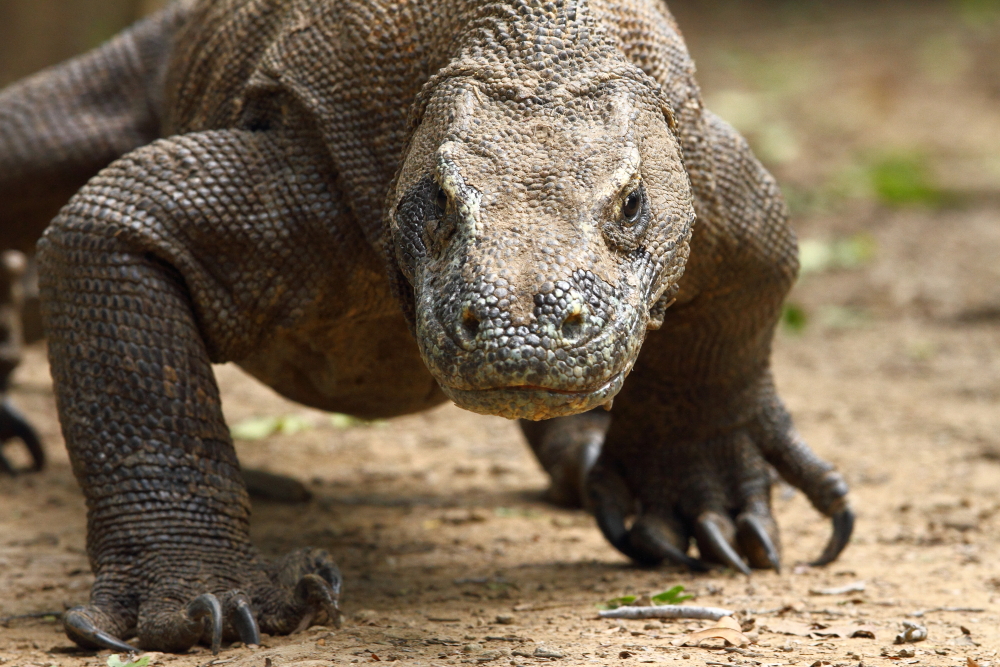
‘Komodo’ is a familiar word to most people and almost everyone has heard of the infamous Komodo Dragons, yet few people seem to know much about Komodo Island itself and the stories behind its most famous inhabitants. This arid 390km² island is one of the smaller islands making up an Indonesian chain known as the Lesser Sundas. This archipelago lies to the east of the Greater Sundas (also known as Sundaland), the latter comprising of the Malay Peninsula and the massive islands as Sumatra, Java and Borneo and the smaller Bali. Just to the east of Bali is a deepwater channel that separates Bali from the next small island, Lombok. Despite the width of this Lombok Strait measuring a mere 35km, it is actually a rather significant feature as it separates the Greater and Lesser Sundas and forms part of a major zoogeographical division known as Wallace’s Line. Please bear with me as I explain the relevance of this fact.
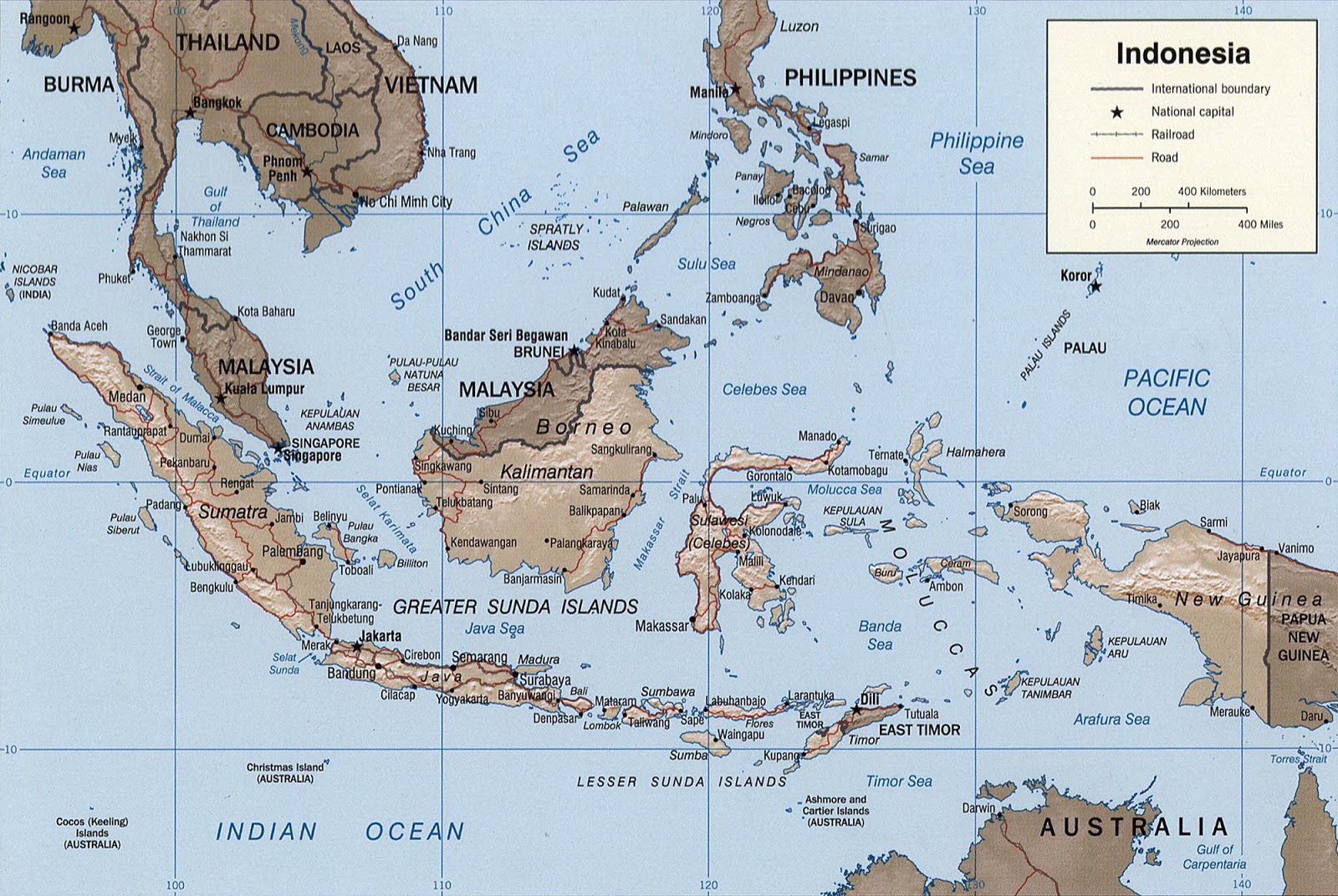
A map of Indonesia showing Wallace’s Line in blue. To the west lie islands harboring Asiatic fauna and to the east is Wallacea harboring a mixed Asiatic and Australasian fauna. Lydekker’s Line in green is the eastern boundary of Wallacea. Komodo is one of the small islands between Sumbawa and Flores in the Lesser Sunda Island chain.
Going back in time to the years 1854-62, a British explorer and natural history collector by the name of Alfred Russel Wallace traveled through a then little known area which he termed ‘The Malay Archipelago,’ and in 1869 published a book by that title which became one of the most popular and influential accounts of scientific exploration written during the 19th century. Besides being the first Westerner to describe living birds-of-paradise in the wild, Wallace discovered more than a thousand new species of birds and other life forms. Since he was collecting as a commercial activity and therefore spending significant time in the region to amass large volumes of specimens (an incredible 125,000!), he had the time and material to reflect upon differences between individuals of species, as well as changes in the diversity of fauna between the numerous islands he explored. The first led him to independently propose natural selection as the driving force of evolution. During 1858 he wrote up this theory whilst still in Indonesia and mailed his ideas to the then already esteemed Charles Darwin who found himself in a rather tough predicament; Wallace has just hit upon the very idea that Darwin has spent the past two decades researching with the intention of publishing. End result was that Darwin rushed a short paper that was delivered to the Linnean Society of London jointly with Wallace’s ideas on evolution. Darwin, being the more well known of the duo at the time ended up being immortalized as the father of the Theory of Evolution through Natural Selection. This was further entrenched by Darwin’s publication the following year of his famous book: ‘On the Origin of Species.’ Some authors have gone as far as claiming that Darwin stole Wallace’s ideas and took all the credit and glory, but Wallace at no stage showed any bitterness at being relegated to the back seat and in fact he became a staunch supporter of Darwin.
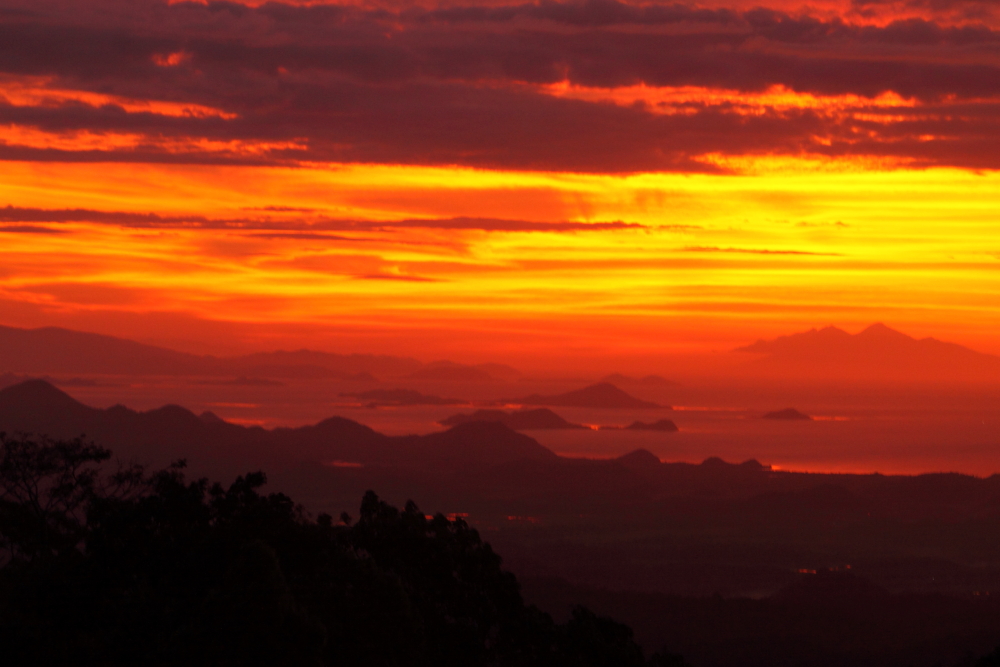
Sunset over the land of the dragons – the view from western Flores over Labuan Bajo Bay and across to Komodo and Rinca Islands. Image by Adam Riley
Wallace also hit upon the concept of zoogeographical boundaries and has been bestowed the title of “father of biogeography”. He noticed that to the west of the Lombok Strait, the fauna of the Greater Sundas was almost purely Asiatic in origin (typical species including apes, rhinos, cats, woodpeckers, barbets etc), yet to the east of this channel, the fauna had a strong Australasian element (typical species including marsupial mammals, cockatoos, honeyeaters, megapodes etc). Wallace therefore proposed a theoretical line, that is now named in his honor as Wallace’s Line. This line continued northwards from the Lombok Strait to another channel that separates Borneo from Sulawesi and here again this rule held true. The region to the east of the line is not purely Australasian, but a strong mix of Asiatic and Australasian fauna. Further eastwards, another clear line can be drawn that divides these islands of mixed fauna and those of almost pure Australasian origin. This is now known as Lydekker’s Line. Subsequent research has proven that these lines correlate to continental plates, the islands west of Wallace’s Line being attached via the Sunda Shelf to continental Asia and those to the east of Lydekker’s Line to the Sahul Plate that connects New Guinea to continental Australia. The islands that lie between these two lines form a combined 347,000km² landmass now called Wallacea. They are not strongly linked to any continental shelves and their fauna, as mentioned, is a fascinating mix of Asiatic and Australasian origin.
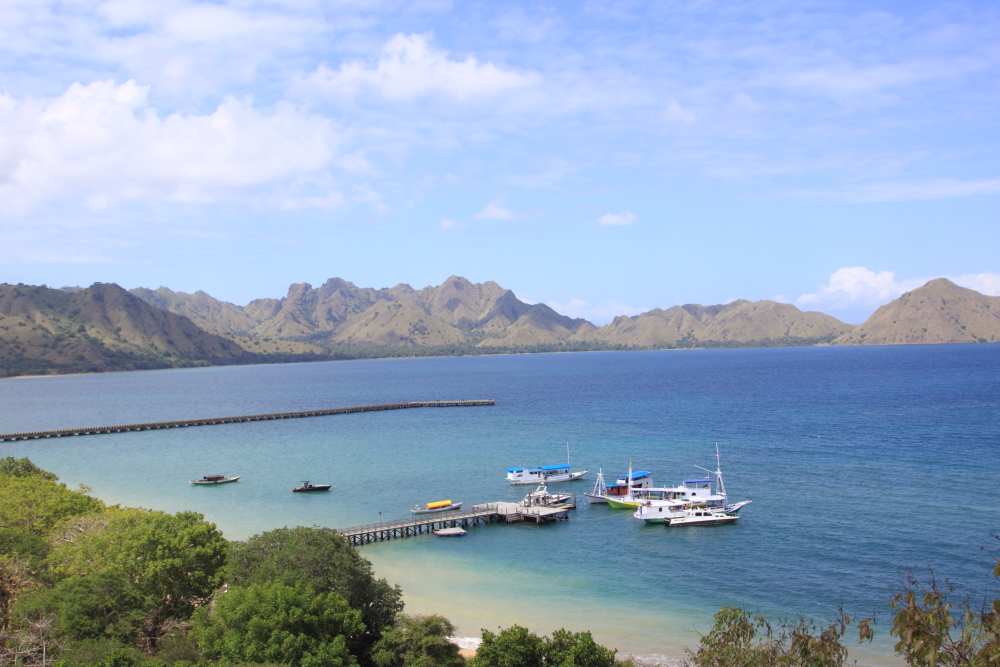
Only day visits are allowed to Komodo Island and all tourists arrive by boat, either on live-aboards or on day trips out of Labuan Bajo on Flores. A view of the jetty and rugged savannas of Komodo Island by Felicity Riley.
The Lesser Sundas form an integral part of Wallacea, and Komodo is just one of the minor Lesser Sunda islands. It is wedged between the much larger islands of Sumbawa and Flores, all of volcanic origin. Komodo has only a single village (growing from only 30 villagers in 1928 to approximately 2,000 residents now) that is of a rather recent origin, the settlement said to have been founded by convicts who were exiled to this remote and rather arid and foreboding island. Stories of fire-spitting dragons exceeding 7m (23ft) in length had been circulating for some time, yet despite sailing alongside Komodo Wallace did not land on the island and missed out on discovering the world’s largest lizard. Only in 1910 did an official of the Dutch Colonial Administration in Flores, Lieutenant Steyn van Hensbroek, mount an expedition of armed soldiers to investigate this fearsome beast. After a few days they managed to kill a Komodo Dragon and introduced this species to the western world. In 1912 the Director of the Zoological Museum in Java, Peter Ouwens, also visited Komodo and collected more specimens and formally described the species as Varanus komodoensis. Such interest was generated by this greatest of all lizards that by 1915 the Dutch government was worried about the conservation of the Komodo Dragon and issued a regulation for their protection.

A Komodo Dragon lumbers forwards. Notice the massive claws used for gripping prey. Image by Adam Riley
Two theories exist as to the reasons for such a huge lizard evolving; the traditional thinking was that the Komodo Dragon was an example of island gigantism, a biological phenomenon whereby island forms tend to evolve into larger taxa (and conversely continental forms become smaller). However recent evidence indicates that the Komodo Dragon is an ancient relict of giant lizards that evolved in Australia but became extinct with other megafauna during the Pleistocene era. Contrary to popular belief, the Komodo Dragon does not only exist on its namesake Komodo Island (which hosts an estimated population of 1,000 animals) but is also found on the nearby smaller islands of Rinca (1,000), Gili Desami (100) and Gili Motang (also 100) as well as western Flores (up to 2,000.) They have recently become extinct on Padar, probably due to extreme hunting pressure on their main prey species. The smaller islands, together totaling 603km² of land, have since 1980 been protected within Komodo National Park, a World Heritage Site. Two reserves have also recently been declared on Flores to protect the dragons. The dragons inhabit grasslands, open savanna, beaches and low elevation monsoon and mangrove forests on these dry islands.
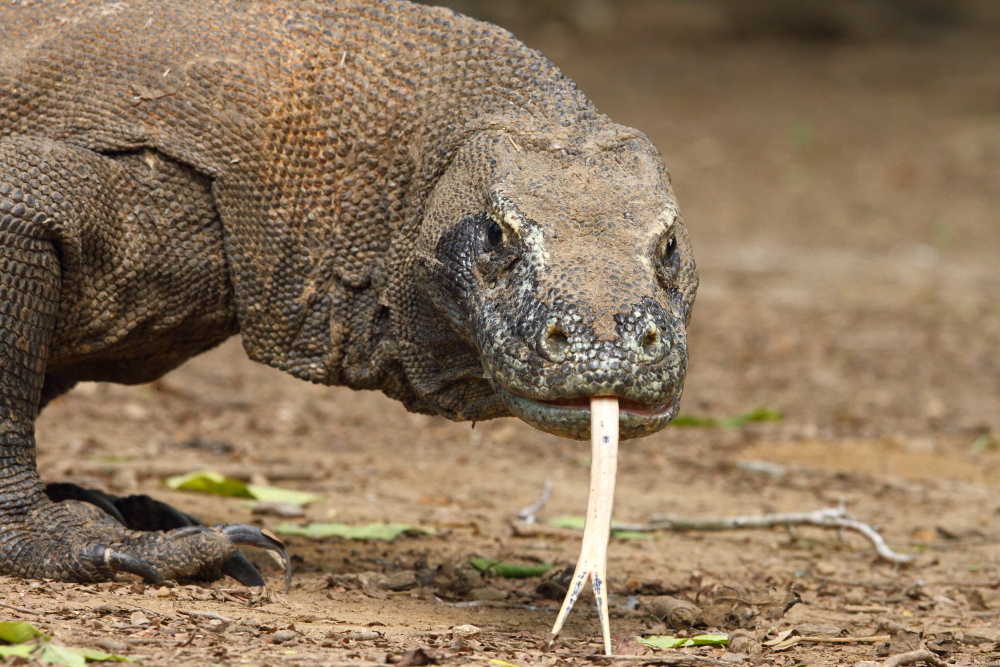
Komodo Dragons constantly flick their enormous tongues which are an essential aid for detecting prey and carrion. Their tongues have both smelling and tasting stimulii. Image by Adam Riley
Measuring up to 3.13m (10ft 3in) and tipping the scales at an average of up to 90kg (198lbs) with a record weight of a wild individual a remarkable 166 kilograms (370lbs), (although this probably included an undigested meal), the Komodo Dragon is the super predator within its distribution. Any creature they can overcome and kill falls within their dietary range; from invertebrates and birds, fellow Komodo Dragons, right up to mammals as large as Water Buffalo and even Humans. The bulk of their diet consists of large mammals that have been introduced to the these islands, notably Timor Deer, Wild Boar, Water Buffalo as well as goats and even feral horses. This obviously begs the question of what their diet comprised before humans introduced these large mammals and some biologist believe that the dragons chief prey item was an extinct species of pygmy elephant!
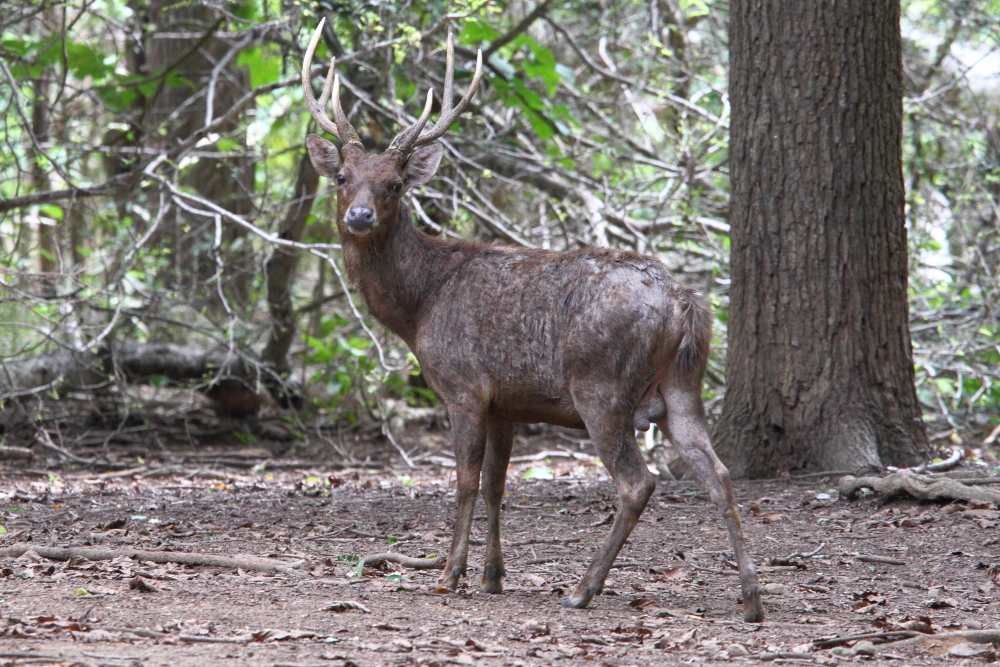
Timor Deer are abundant on Komodo Island and are the main prey of the Komodo Dragons. Image by Adam Riley.
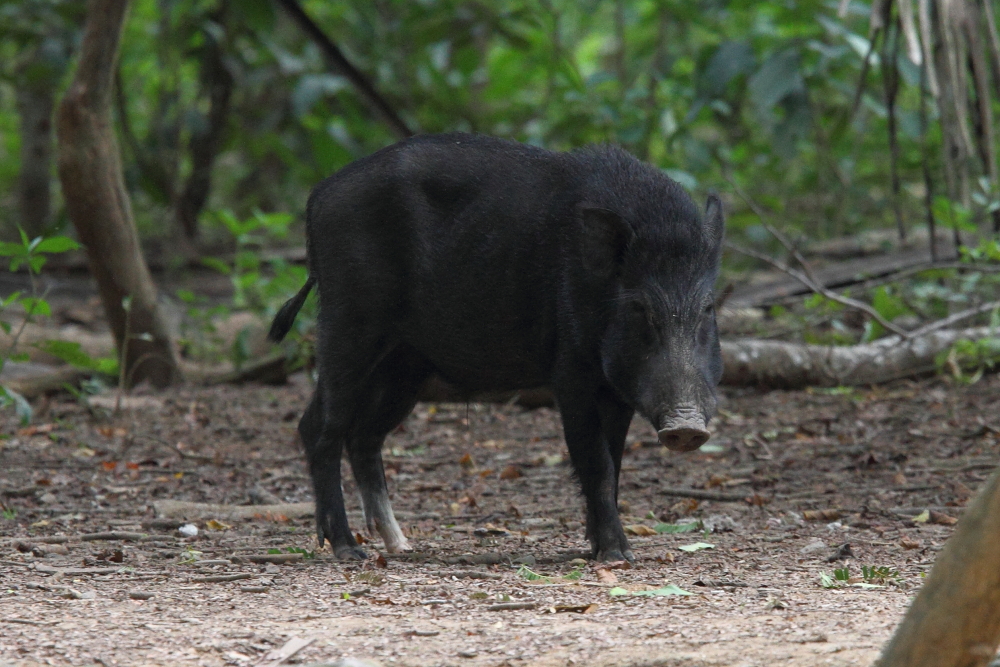
Wild Boar also occur in good numbers, the dragons are able to swallow them whole! Image by Adam Riley.
Komodo Dragons are exceptional amongst reptiles for their group co-operative hunting methods. Ambush is their chief method of attack and they lunge for the throat or underside of their prey, and they can knock down large mammals with their tails. They also feed extensively on carrion and their sense of smell allows them to detect a dead or dying animal up to 9.5km (5.9mi) away! For subduing such large prey, it’s not their massive claws or 60 frequently replaced, serrated teeth (that can measure up to 2.5cm (1in) in length), but their saliva that is critical. They secrete copious amounts of this liquid that is frequently blood-tinged, due to their teeth being almost completely covered by gingival tissue that is naturally lacerated during feeding. This creates an ideal culture for the over 60 strains of frightfully virulent bacteria that have been found to thrive in Komodo Dragons’ mouths. It still remains a mystery that the dragons themselves are unaffected by these bacteria. Furthermore, it has been found that Komodo Dragons have two venom glands in their lower jaw containing toxins that inhibit blood clotting, lower blood pressure, cause muscle paralysis and hypothermia, leading to loss of consciousness in envenomated prey. It is assumed that the combination of their virulent saliva and venom will immobilize any prey item that escapes the initial attack.
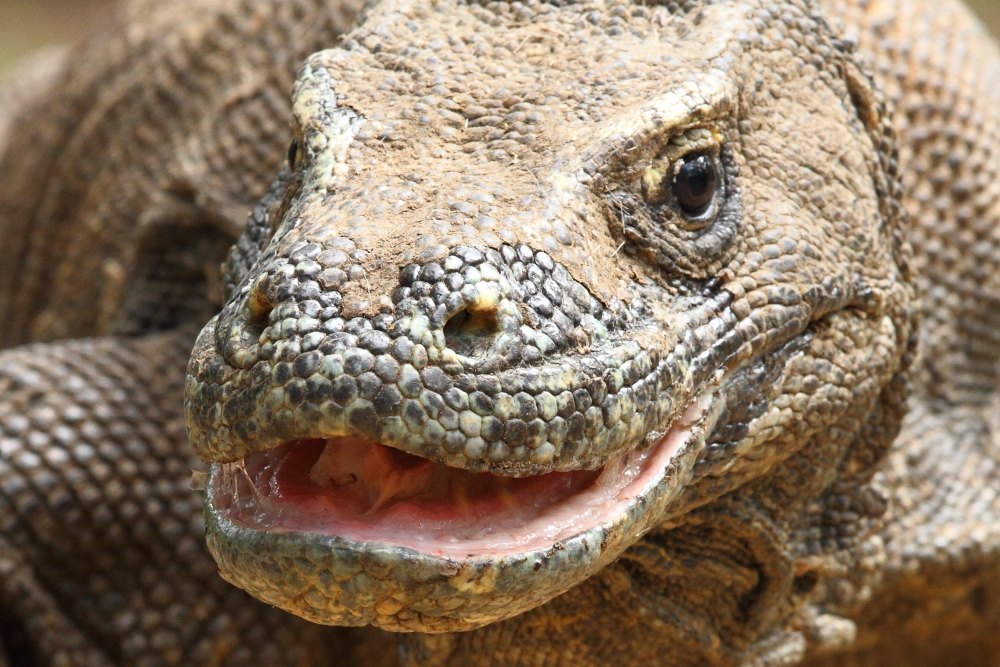
The Komodo Dragon’s saliva is both copious and remarkably virulent. Image by Adam Riley
Animals up to the size of goats are swallowed whole, this process being aided by the dragon’s loosely articulated jaws, flexible skull and expandable stomach. Nevertheless this can be a slow process despite the saliva lubricating the meal and Komodo Dragons have been observed to ram carcasses against trees (sometimes even knocking trees down in the process) to force large prey items down their throats! A small tube under their tongue is connected to their lungs allowing them to breath during this process. Chunks are torn off animals too large to swallow whole. The dragons can consume up to 80% of their body weight in a single sitting and can survive on just a dozen meals in a year! The largest male dragons assert their dominance and feed first, while the smaller individuals follow in hierarchy. Smaller males show their submission with submissive body language and loud steam train-like hisses, while dragons of similar size do resort to physical combat, the loser fleeing if he is not killed and eaten by the victor!
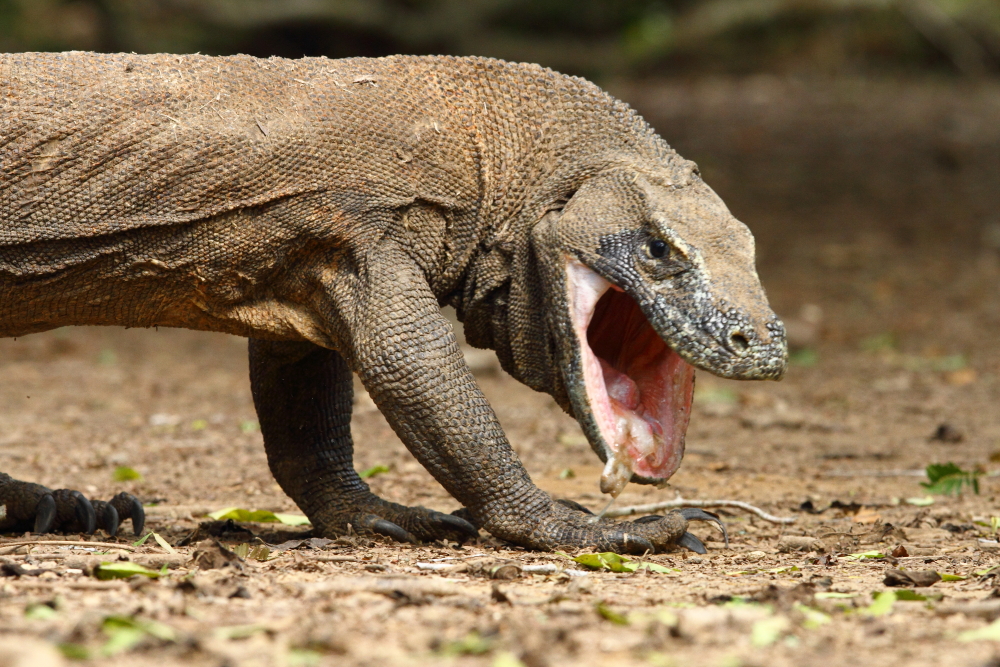
A Komodo Dragon in the process of regurgitating unwanted portions of its previous meal, this is commonly practiced by these animals. Image by Adam Riley
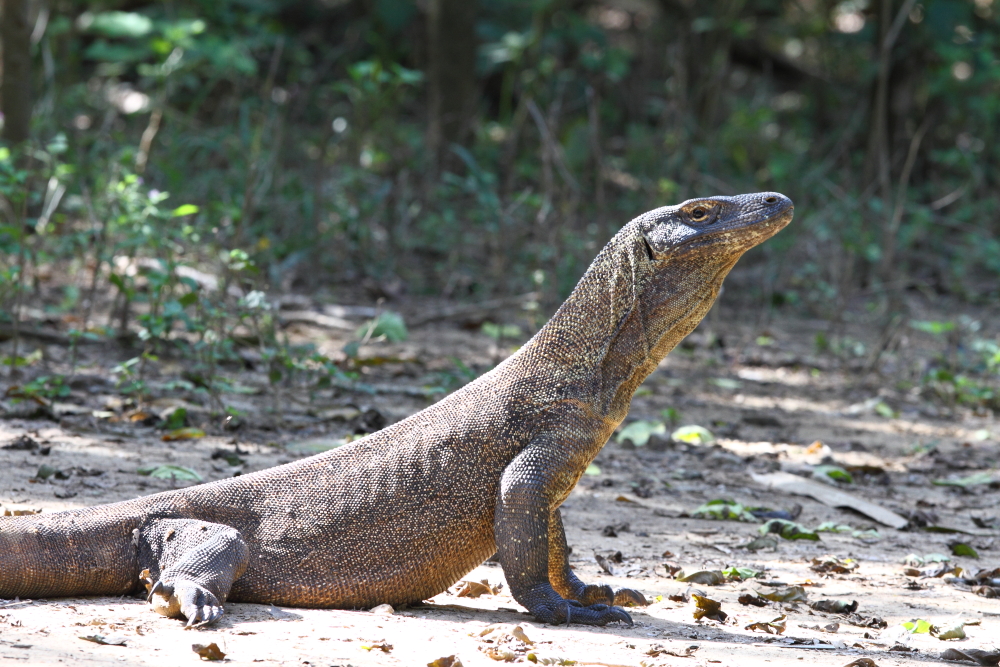
A younger Komodo Dragon – these smaller individuals can be very aggressive and are extremely fast moving, essential for catching prey as well as avoiding their cannibalistic elders. Image by Adam Riley
Komodo Dragons have a breeding season, with mating taking place between May and August and egg-laying in September. Males fight each other for access to females, and also need to wrestle and immobilize the antagonistic females during coitus. They however do form pair bonds which is very unusual amongst reptiles. About 20 eggs are usually laid in Orange-footed Scrubfowl mounds or self excavated burrows and are incubated for seven to eight months, hatching in April when insects are most plentiful. Young dragons become arboreal to avoid their cannibalistic seniors and are extremely wary. Maturity is achieved after 8-9 years and their lifespan can reach 50 years. Komodo Dragons are known to perform parthenogenesis, meaning that females can lay fertile eggs that produce male offspring without any contact with males of the species. This adaptation can allow a single female to colonize an island, hatch male offspring with which it can later reproduce to produce offspring of both sexes.
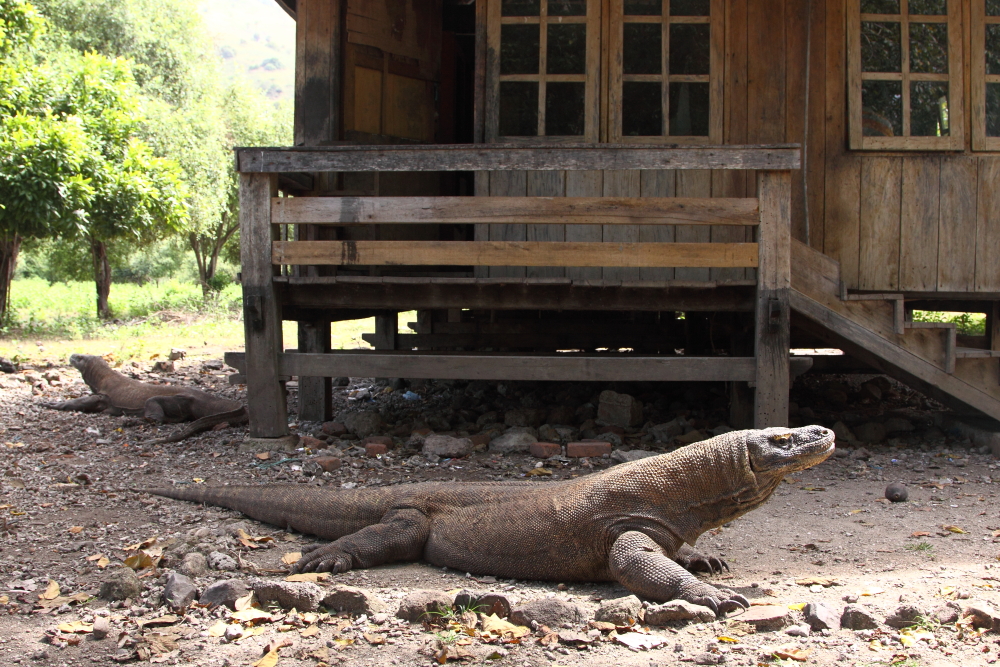
Komodo Dragons gather around the staff kitchen at the park headquarters where they are attracted by the the odors of meals in preparation. Image by Adam Riley
Komodo Dragons are unpredictable and can suddenly become aggressive. When visiting Komodo Island it is mandatory to be accompanied by a park ranger who is armed with a forked stick. With this instrument, they push any threatening dragons away by wedging the stick on the dragon’s neck. It is generally the smaller and faster subadults and females that are most dangerous. During our visit, our guide showed us scars on his knee where a young dragon had bitten him whilst he had let down his guard during a nap! A dragon bite is extremely painful and usually results in weeks of hospitalization to fight infection.
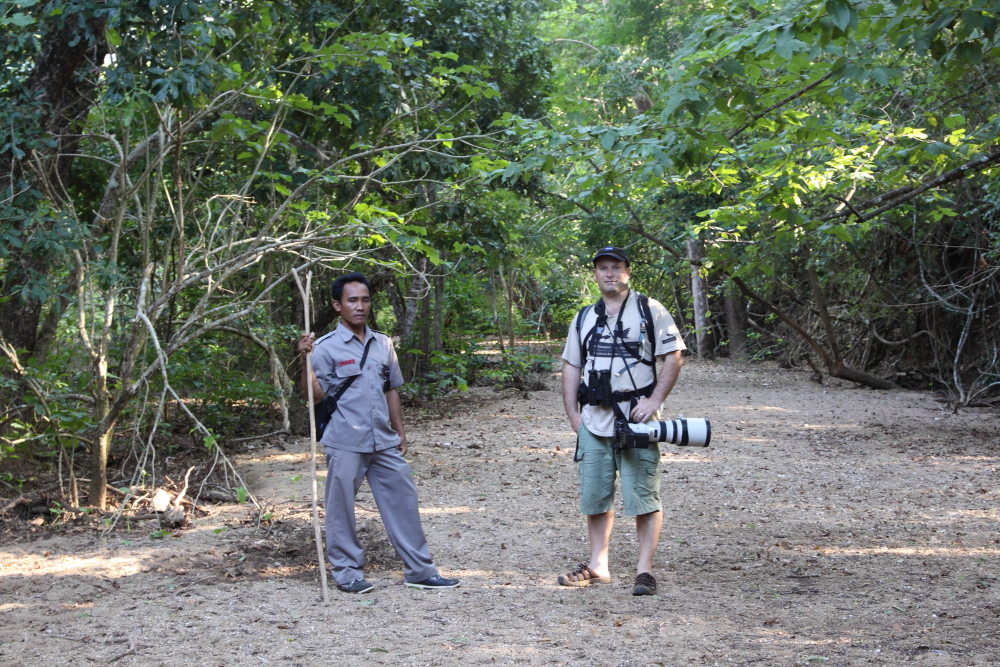
The author on Komodo Island accompanied by a park ranger – notice the forked stick which is carried at all times to deter any Komodo Dragon attacks. Image by Felicity Riley
Komodo is home to far more than these incredible lizards; 32 mammal species, 128 birds and 37 reptile species are known from Komodo National Park. Native mammals occurring on Komodo Island include the Asian Palm Civet and several bat and rodent species, most specially the little known and highly localized Rinca Rat. Birds are prolific, and a birder is well rewarded by an early morning visit to Komodo Island. During our morning’s exploration we had numerous superb birding experiences, and highlights included Green Junglefowl, Orange-footed Scrubfowl, the Critically Endangered Yellow-crested Cockatoo, large numbers of Green Imperial-Pigeon, the lovely Barred Dove, Little Cuckoo-Dove, Island Collared-Dove, White-bellied Sea Eagle, Brahminy Kite (nesting), Pacific Koel, Edible-nest Swiftlet, Black-naped Oriole, Black-naped Monarch (particularly common), Wallacean Drongo, Collared Kingfisher, Blue-tailed Bee-eater, Sunda Pygmy Woodpecker, Australian Golden Whistler, Olive-backed Sunbird, Black-fronted Flowerpecker, Lemon-bellied White-eye, Black-faced Munia and Helmeted Friarbird. This list of birds reflects the mixed nature of the avifauna of these Wallacean Islands – for example the scrubfowl, cockatoo, whistler and friarbird being of Australasian origin; the junglefowl, coucal, sunbird and oriole of Asiatic origin and the kingfisher, white-eye, cuckoo-dove and imperial-pigeon being widespread island colonists.
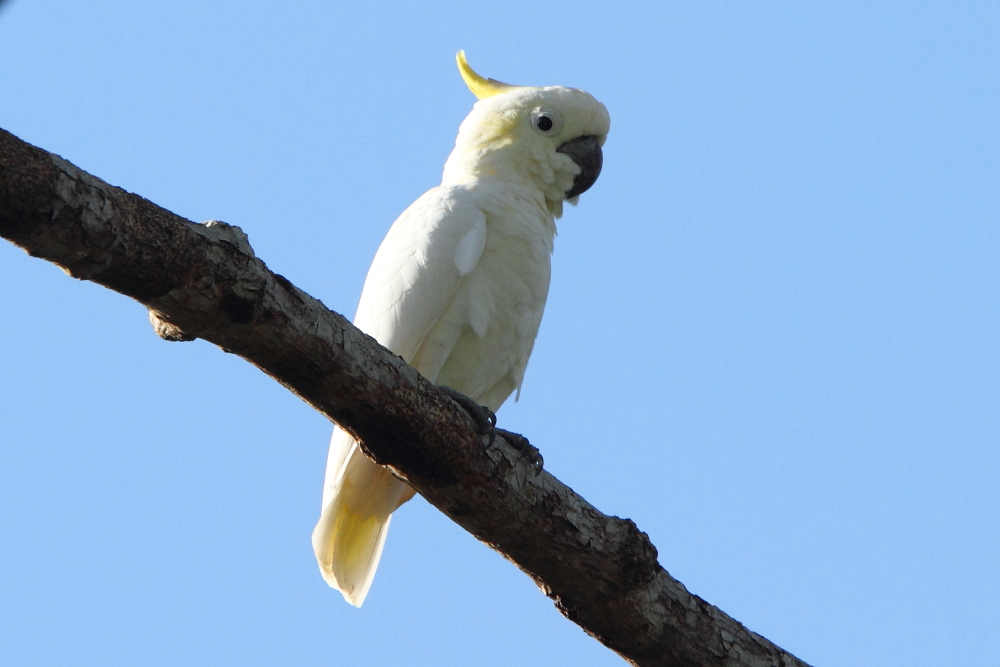
The Critically Endangered Yellow-crested Cockatoo is Komodo’s key bird and is nowhere as easily found as on this island. Cockatoo’s belong to a bird family with strong Australasian roots. Image by Adam Riley
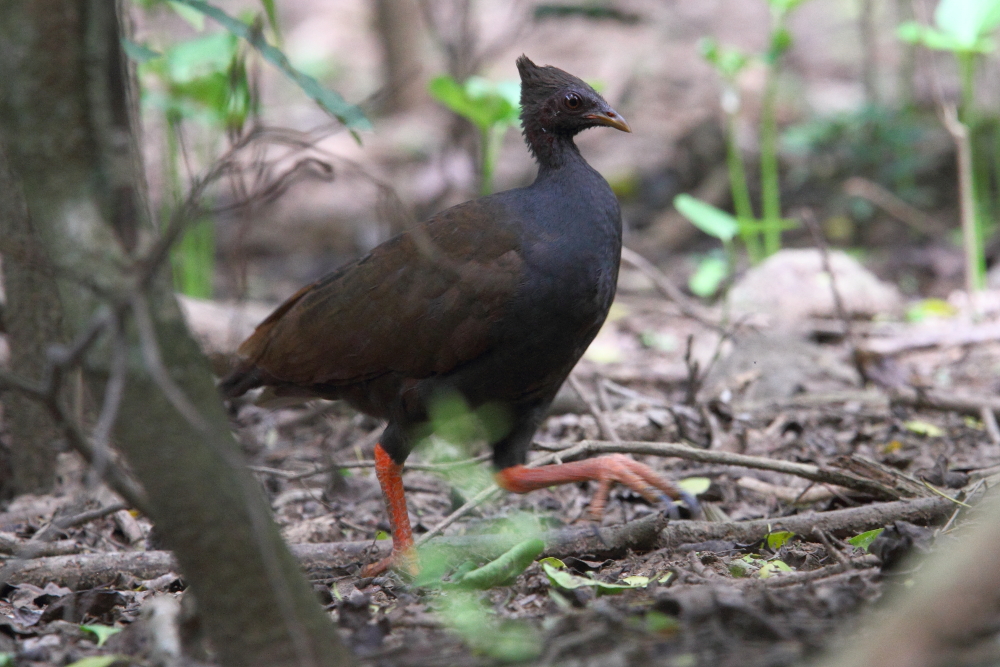
Another species from an Australasian family, the Orange-footed Scrubfowl or Megapode. These birds lay their eggs in mounds of vegetation and Komodo Dragons often use their abandoned mounds as their own nesting sites. Image by Adam Riley
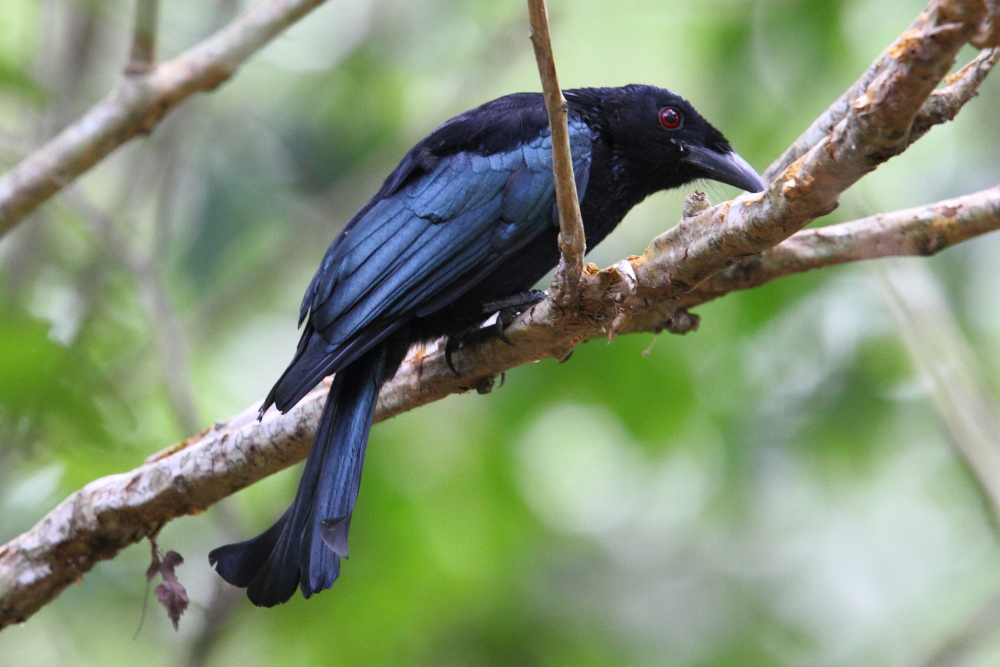
The Wallacean Drongo is an attractive endemic to Wallacea and commonly encountered on Komodo Island. Image by Adam Riley
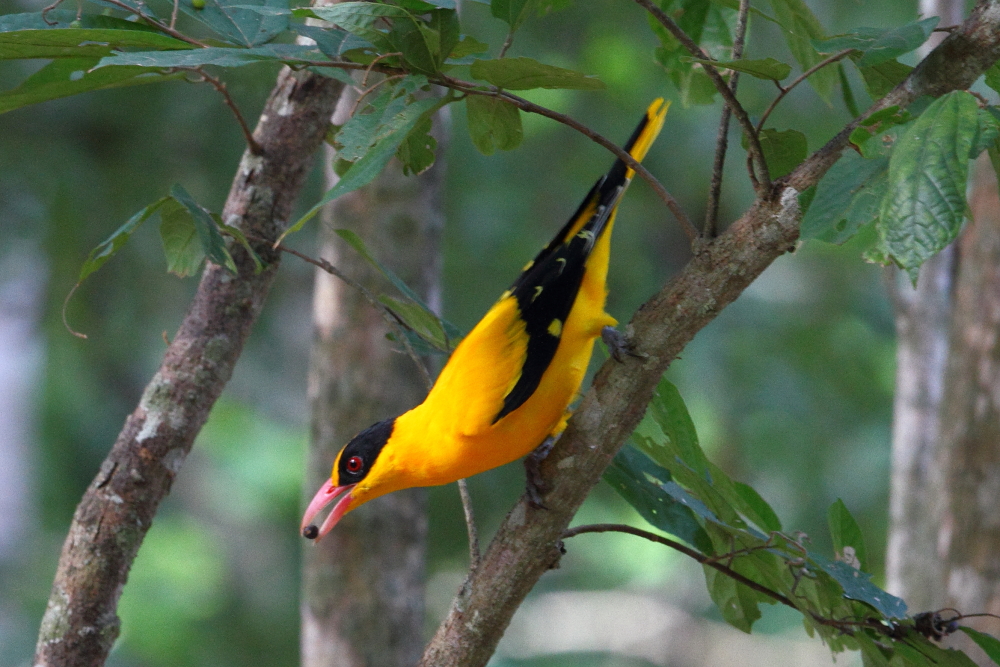
The beautiful Black-naped Oriole is an Asiatic species that is also readily encountered on Komodo Island. Image by Adam Riley
More than 1,000 species of fish (including numerous brilliantly colorful reef fish), 260 species of coral and 70 species of sponges, as well as Dugong, 14 cetacean species and nesting turtles are known from the waters of the national park. Snorkeling off the stunning and aptly named Pink Beach on Komodo Island was one of our best coral reef experiences in Indonesia.
Komodo Island is without a doubt one of the world’s must visit locations for wildlife enthusiasts and birders.
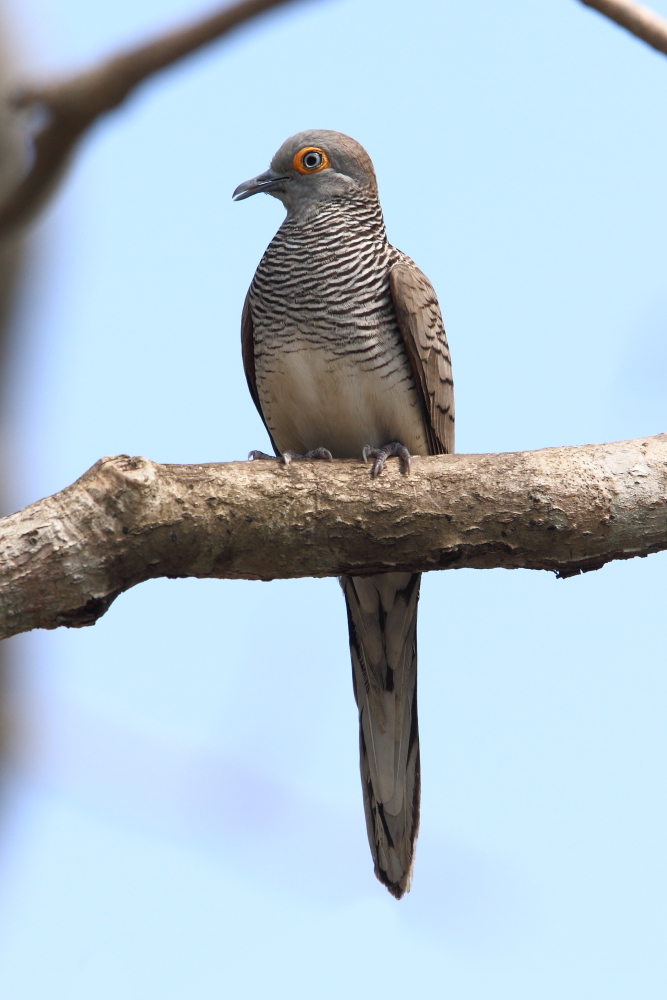
The lovely Barred Dove is an Indonesian endemic occurring on Komodo Island. Image by Adam Riley.
